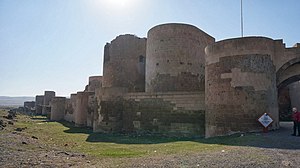| Siege of Ani | |||||||
|---|---|---|---|---|---|---|---|
| Part of Byzantine–Seljuk wars | |||||||
 Ani walls. | |||||||
| |||||||
| Belligerents | |||||||
| Byzantine Empire | Seljuk Empire | ||||||
| Commanders and leaders | |||||||
|
Duke Bagrat Gregory |
Alp Arslan Nizam al-Mulk | ||||||
| Strength | |||||||
| Unknown | Unknown | ||||||
| Casualties and losses | |||||||
| Heavy | Unknown | ||||||
In 1064, the Seljuk Sultan, Alp Arslan, besieged the fortified city of Ani. After a siege of 25 days, the Seljuks captured the city.
Background
In 961, king Ashot III (953–77) transferred the capital from Kars to Ani. Ani expanded rapidly during the reign of King Smbat II economically and culturally. [1] In the 10th century, the population was perhaps 50,000–100,000. [2] Its renown was such that it was known as the "city of forty gates" and the "city of a thousand and one churches." Ani also became the site of the royal mausoleum of Bagratuni kings. [3]
In 1045, the Byzantine emperor, Constantine IX Monomachos, organized a new expedition for the conquest of the city. assisted by the shaddadid ruler, Abu'l-Aswar Shavur ibn Fadl. The Armenian king, Gagik II, was invited by the emperor to Constantinople, declaring he would be made ruler of Ani and Shirak. Gagik accepted, and thus Ani fell to the Byzantines; however, it was a ruse. The Byzantines deposed Bagratuni dynasty and other local people and appointed mercenaries to rule the city. [4]
During this time, the Seljuks began a military expedition to northeastern Anatolia under Ibrahim Inal and Tughril I. [5]
Prelude
The newly consolidated Seljuk sultan, Alp Arslan, aimed to increase the size of his borders in 1064, beginning with the wealthy neighboring regions of Armenia and Iberia. Setting out to mount a campaign, he gathered skilled Arab and Persian technicians to outfit his army with siege engines. [6]
Ani served as the campaign's strategic goal. The Sultan proceeded in a circle, subduing the mountainous regions north of Ani before moving on to Georgia, where he defeated and vassalized King Bagrat IV. Before that, the Byzantine strongholds in the Araxes Valley and further west were taken by another division led by Vizier Nizam al-Mulk. These two Seljuk armies joined together on Ani at the start of July 1064. [6]
Siege
The city was commanded by two Byzantine generals, Duke Bagrat and Gregory. [7] The city was said to be impossible to conquer. [8] The city was located on a rocky peninsula overhanging a rapid river. A deep ravine to the west of the river protected the city. [9] The Seljuks began setting up their tents, and the garrison cavalry initially thought they were merchants. However, they realized the truth, and they fled to the city. [10]
The defenders were ill-prepared and in short supply, which put them in a difficult situation. In addition, supplies were scarce, and there was a strained relationship between the populace and the commanders. [11] [6] According to Ibn al-Athir, the sultan, realizing he could not breach the walls, ordered the construction of battering rams, placed hay on top of them, and had the soldiers inside to attack. [12]
Meanwhile, the Seljuks managed to destroy a portion of the walls due to undermining works with underground tunnels. The Seljuks entered the city on August 16 after a siege of 25 days. [6] [13] The defenders of the walls escaped and fortified themselves for a while in the citadel, but later escaped. [6] The commanders of the city were captured. [14]
Aftermath
The massive silver cross from the Ani Cathedral was taken down and set down on the Nakhichevan Mosque's doorstep so that worshippers could tread on it as they entered. [6] Alp Arslan made his first Friday prayer in the cathedral, which changed its name to Fethiye Mosque. [15] However, the city was quickly rebuilt. The Sultan had a portion of the prisoners rebuild the destroyed houses and walls and occupy them with new settlers. [16]
The Abbasid caliph, Al-Qa'im, praised the Sultan for his victory and gave him the title "Abul-Fath." [17] The Armenian king of Kars, Gagik, pledged allegiance to the Sultan; however, he left the city and gave his lands to the Byzantines. [18] [19] [20]
References
- ^ Oktay Belli, p. 58–9.
- ^ Redgate, Anne Elizabeth. The Armenians. Oxford: Blackwell Publishers, 1998, p. 210.
- ^ Manuk-Khaloyan, Armen, "In the Cemetery of Their Ancestors: The Royal Burial Tombs of the Bagratuni Kings of Greater Armenia (890-1073/79)", Revue des Études Arméniennes 35 (2013): 147–155.
- ^ Oktay Belli, p. 61-2
- ^ Oktay Belli, p. 62
- ^ a b c d e f Byzantine Battles, Capture of Ani (1064)
- ^ Frederick William Bussell, p. 454
- ^ Oktay Belli, p. 62
- ^ George Finlay, p. 18
- ^ Oktay Belli, p. 62
- ^ George Finlay, p. 18
- ^ Oktay Belli, p. 63
- ^ Oktay Belli, p. 63
- ^ Oktay Belli, p. 63
- ^ Oktay Belli, p. 63
- ^ Frederick William Bussell, p. 454
- ^ Oktay Belli, p. 63
- ^ Oktay Belli, p. 64
- ^ Frederick William Bussell, p. 454
- ^ George Finlay, p. 18
Sources
- Oktay Belli (2021), Ani in Every Aspect. [1]
- Frederick William Bussell (1910), The Roman Empire, Essays on the Constitutional History from the Accession of Domitian (81 A. D.) to the Retirement of Nicephorus III (1081 A.D.). [2]
- George Finlay (1877), The Byzantine and Greek empires, pt. 2, A.D. 1057-1453. [3]